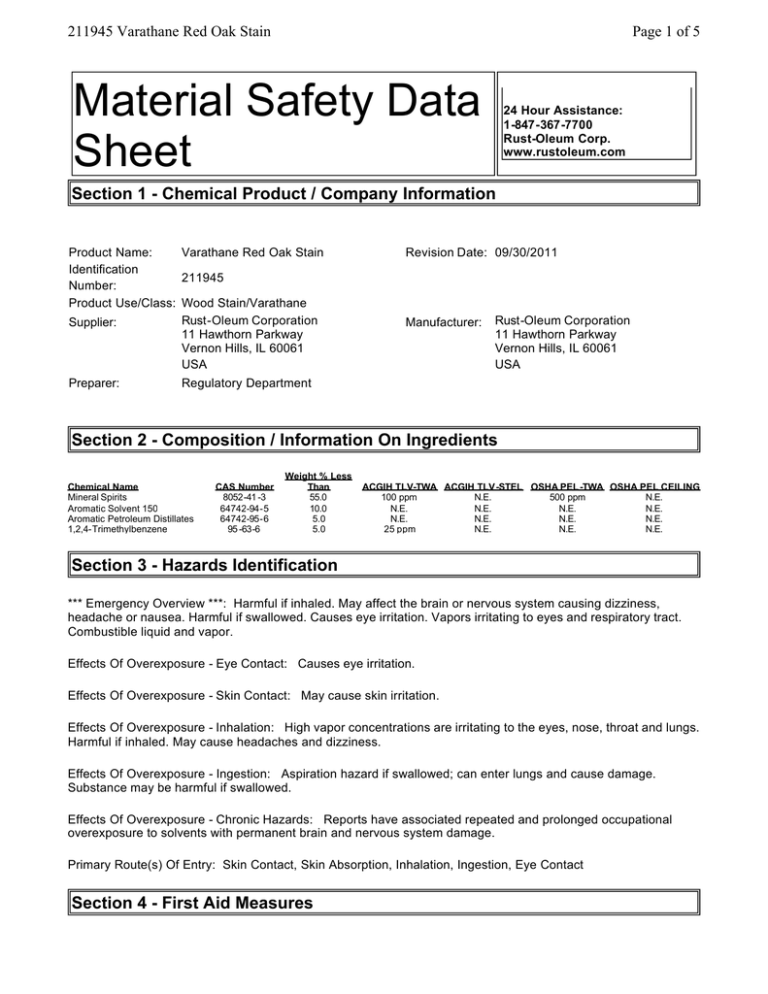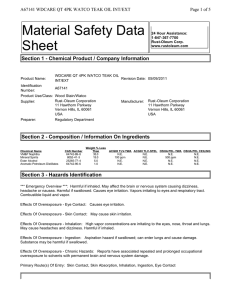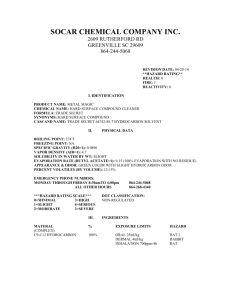Material Safety Data Sheet - Rust
advertisement

211945 Varathane Red Oak Stain Page 1 of 5 Material Safety Data Sheet 24 Hour Assistance: 1-847-367-7700 Rust-Oleum Corp. www.rustoleum.com Section 1 - Chemical Product / Company Information Product Name: Varathane Red Oak Stain Identification 211945 Number: Product Use/Class: Wood Stain/Varathane Rust-Oleum Corporation Supplier: 11 Hawthorn Parkway Vernon Hills, IL 60061 USA Preparer: Revision Date: 09/30/2011 Manufacturer: Rust-Oleum Corporation 11 Hawthorn Parkway Vernon Hills, IL 60061 USA Regulatory Department Section 2 - Composition / Information On Ingredients Chemical Name Mineral Spirits Aromatic Solvent 150 Aromatic Petroleum Distillates 1,2,4-Trimethylbenzene CAS Number 8052-41 -3 64742-94-5 64742-95-6 95 -63-6 Weight % Less Than 55.0 10.0 5.0 5.0 ACGIH TLV-TWA ACGIH TLV-STEL OSHA PEL -TWA OSHA PEL CEILING 100 ppm N.E. 500 ppm N.E. N.E. N.E. N.E. N.E. N.E. N.E. N.E. N.E. 25 ppm N.E. N.E. N.E. Section 3 - Hazards Identification *** Emergency Overview ***: Harmful if inhaled. May affect the brain or nervous system causing dizziness, headache or nausea. Harmful if swallowed. Causes eye irritation. Vapors irritating to eyes and respiratory tract. Combustible liquid and vapor. Effects Of Overexposure - Eye Contact: Causes eye irritation. Effects Of Overexposure - Skin Contact: May cause skin irritation. Effects Of Overexposure - Inhalation: High vapor concentrations are irritating to the eyes, nose, throat and lungs. Harmful if inhaled. May cause headaches and dizziness. Effects Of Overexposure - Ingestion: Aspiration hazard if swallowed; can enter lungs and cause damage. Substance may be harmful if swallowed. Effects Of Overexposure - Chronic Hazards: Reports have associated repeated and prolonged occupational overexposure to solvents with permanent brain and nervous system damage. Primary Route(s) Of Entry: Skin Contact, Skin Absorption, Inhalation, Ingestion, Eye Contact Section 4 - First Aid Measures 211945 Varathane Red Oak Stain Page 2 of 5 First Aid - Eye Contact: Immediately flush eyes with plenty of water for at least 15 minutes holding eyelids open. Get medical attention. Do NOT allow rubbing of eyes or keeping eyes closed. First Aid - Skin Contact: Wash with soap and water. Get medical attention if irritation develops or persists. First Aid - Inhalation: Remove to fresh air. If not breathing, give artificial respiration. If breathing is difficult, give oxygen. Get immediate medical attention. Do NOT use mouth-to -mouth resuscitation. First Aid - Ingestion: Aspiration hazard: Do not induce vomiting or give anything by mouth because this material can enter the lungs and cause severe lung damage. Get immediate medical attention. Section 5 - Fire Fighting Measures Flash Point: 106 F (Setaflash) Extinguishing Media: Film Forming Foam, Carbon Dioxide, Dry Chemical, Dry Sand, Water Fog Unusual Fire And Explosion Hazards: Keep containers tightly closed. Special Firefighting Procedures: Evacuate area and fight fire from a safe distance. Water may be used to cool closed containers to prevent pressure buildup and possible autoignition or explosion. Section 6 - Accidental Release Measures Steps To Be Taken If Material Is Released Or Spilled: Contain spilled liquid with sand or earth. DO NOT use combustible materials such as sawdust. Dispose of according to local, state (provincial) and federal regulations. Do not incinerate closed containers. Section 7 - Handling And Storage Handling: Wash thoroughly after handling. Wash hands before eating. Avoid breathing vapor or mist. Follow all MSDS/label precautions even after container is emptied because it may retain product residues. Avoid contact with eyes. Storage: Keep container closed when not in use. Keep containers tightly closed. Isolate from heat, electrical equipment, sparks and open flame. Keep away from heat, sparks, flame and sources of ignition. Section 8 - Exposure Controls / Personal Protection Engineering Controls: Use process enclosures, local exhaust ventilation, or other engineering controls to control airborne levels below recommended exposure limits. Prevent build-up of vapors by opening all doors and windows to achieve cross-ventilation. Respiratory Protection: A respiratory protection program that meets OSHA 1910.134 and ANSI Z88.2 requirements must be followed whenever workplace conditions warrant a respirator's use. A NIOSH/MSHA approved air purifying respirator with an organic vapor cartridge or canister may be permissible under certain circumstances where airborne concentrations are expected to exceed exposure limits. Protection provided by air purifying respirators is limited. Use a positive pressure air supplied respirator if there is any potential for an uncontrolled release, exposure levels are not known, or in any other circumstances where air purifying respirators may not provide adequate protection. 211945 Varathane Red Oak Stain Page 3 of 5 Skin Protection: Nitrile or Neoprene gloves may afford adequate skin protection. Use impervious gloves to prevent skin contact and absorption of this material through the skin. Eye Protection: Use safety eyewear designed to protect against splash of liquids. Other protective equipment: Refer to safety supervisor or industrial hygienist for further information regarding personal protective equipment and its application. Hygienic Practices: Wash thoroughly with soap and water before eating, drinking or smoking. Section 9 - Physical And Chemical Properties Vapor Density: Appearance: Solubility in H2O: Specific Gravity: Physical State: Heavier than Air Liquid Slight 0.845 Liquid Odor: Evaporation Rate: Freeze Point: pH: Solvent Like Slower than Ether N.D. N.D. (See section 16 for abbreviation legend) Section 10 - Stability And Reactivity Conditions To Avoid: Avoid all possible sources of ignition. Incompatibility: Incompatible with strong oxidizing agents, strong acids and strong alkalies. Hazardous Decomposition: When heated to decomposition, it emits acrid smoke and irritating fumes. By open flame, carbon monoxide and carbon dioxide. Hazardous Polymerization: Will not occur under normal conditions. Stability: This product is stable under normal storage conditions. Section 11 - Toxicological Information Chemical Name Mineral Spirits Aromatic Solvent 150 Aromatic Petroleum Distillates 1,2,4-Trimethylbenzene LD50 4900 mg/kg (Rat) 4900 mg/kg (Rat) 4900 mg/kg (Rat) N.E. LC50 >1400 ppm (Rat, 4Hr) >1400 ppm (Rat, 4Hr) N.E. N.E. Section 12 - Ecological Information Ecological Information: Product is a mixture of listed components. Section 13 - Disposal Information Disposal Information: Dispose of material in accordance to local, state and federal regulations and ordinances. Do not allow to enter storm drains or sewer systems. 211945 Varathane Red Oak Stain Page 4 of 5 Section 14 - Transportation Information Proper Shipping Name: Hazard Class: UN Number: Packing Group: Limited Quantity: Domestic (USDOT) Paint, Not Regulated N.A. N.A. N.A. No International (IMDG) Paint 3 UN1263 III IMDG 34-08, 3.4.7 Air (IATA) Paint 3 UN1263 III Yes Section 15 - Regulatory Information CERCLA - SARA Hazard Category This product has been reviewed according to the EPA "Hazard Categories" promulgated under Sections 311and 312 of the Superfund Amendment and Reauthorization Act of 1986 (SARA Title III) and is considered, under applicable definitions, to meet the following categories: IMMEDIATE HEALTH HAZARD, CHRONIC HEALTH HAZARD, FIRE HAZARD SARA Section 313: Listed below are the substances (if any) contained in this product that are subject to the reporting requirements of Section 313 of Title III of the Superfund Amendment and Reauthorization Act of 1986 and 40 CFR part 372: Toxic Substances Control Act: Listed below are the substances (if any) contained in this product that are subject to the reporting requirements of TSCA 12(B) if exported from the United States: U.S. State Regulations: As follows New Jersey Right-to-Know: The following materials are non-hazardous, but are among the top five components in this product. Chemical Name Vegetable Oil Alkyd Resin Alkyd Resin CAS Number 8001-22-7 PROPRIETARY PROPRIETARY Pennsylvania Right-to-Know: The following non-hazardous ingredients are present in the product at greater than 3%. Chemical Name Vegetable Oil Alkyd Resin International Regulations: As follows CANADIAN WHMIS: CAS Number 8001-22-7 PROPRIETARY 211945 Varathane Red Oak Stain Page 5 of 5 This MSDS has been prepared in compliance with Controlled Product Regulations except for the use of the 16 headings. CANADIAN WHMIS CLASS: B3 D2A D2B Section 16 - Other Information HMIS Ratings: Health: 2* Flammability: 2 Physical Hazard: 0 NFPA Ratings: Health: 2 Flammability: 2 Instability: 0 Personal Protection: X VOLATILE ORGANIC COMPOUNDS, g/L: 545 REASON FOR REVISION: Regulatory Update Legend: N.A. - Not Applicable, N.E. - Not Established, N.D. - Not Determined Rust-Oleum Corporation believes, to the best of its knowledge, information and belief, the information contained herein to be accurate and reliable as of the date of this material safety data sheet. However, because the conditions of handling, use, and storage of these materials are beyond our control, we assume no responsibility or liability for personal injury or property damage incurred by the use of these materials. Rust-Oleum Corporation makes no warranty, expressed or implied, regarding the accuracy or reliability of the data or results obtained from their use. All materials may present unknown hazards and should be used with caution. The information and recommendations in this material safety data sheet are offered for the users’ consideration and examination. It is the responsibility of the user to determine the final suitability of this information and to comply with all applicable international, federal, state, and local laws and regulations.




